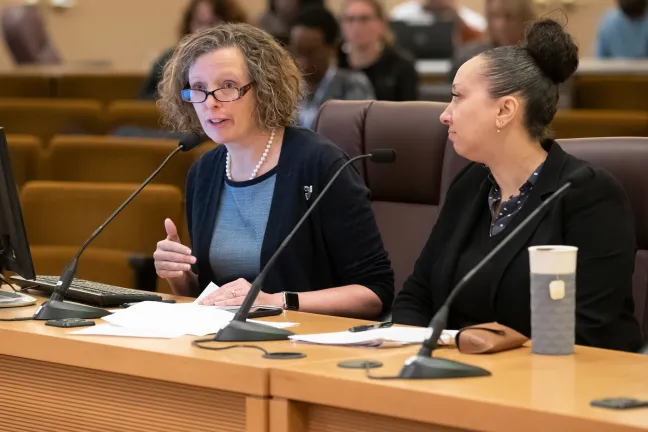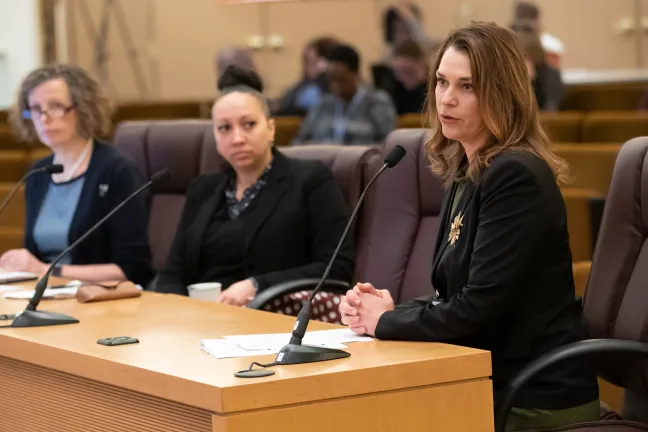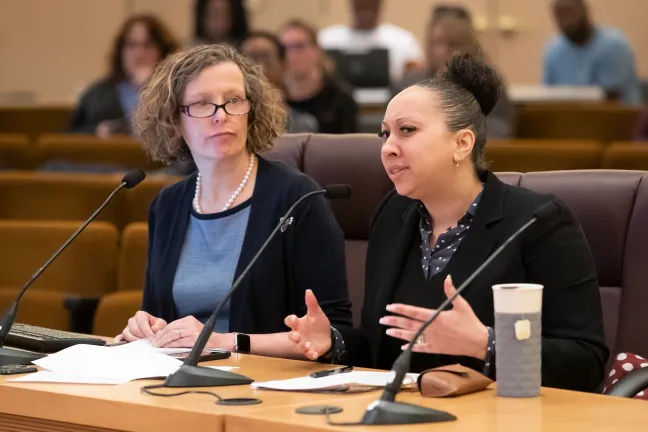Health officials on Nov. 5 presented Multnomah County’s Board of Commissioners with options for restricting the sale of flavored vaping and tobacco products to curb youth smoking and vaping and to reduce health disparities among people of color.
The Board in coming weeks will consider a number of options including restricting the sale of these products entirely or restricting sales to retailers who serve people 21 and older.
The Board has invited people to comment on the options at two hearings:
-
Tuesday, Nov. 12: 10 to 11 a.m., Multnomah Building, 501 S.E. Hawthorne Blvd., Portland
-
Tuesday, Dec. 3: 4:30 to 6:30 p.m., Multnomah County East Building, 600 N.E. 8th St., Gresham
Those who wish to comment on any proposed flavor restriction may also submit written comments online. (Link removed. Public comment period closed.)
“This board has taken some bold action” previously to restrict youth access to tobacco and e-cigarettes, Chair Deborah Kafoury said during Tuesday’s briefing. “But we know our good work has not been enough to stop the growth of vaping among youth in our community.”
How we got here
Federal, state, and local governments have sought to limit youth access to tobacco for decades. In 1998, states entered into a Master Settlement Agreement with tobacco companies to prohibit marketing to youth. The settlement noted that a company was violating the agreement if they intentionally targeted youth, but also if the manufacturer knew youth were responding to a specific product.
In 2009, Congress passed the Family Smoking Prevention and Tobacco Control Act, disclosing ingredients, requiring warning labels and banning flavored cigarettes. After lobbying by tobacco companies, lawmakers omitted menthol from the list of banned flavors. But two years later, the Food and Drug Administration’s Tobacco Products Scientific Advisory Committee recommended, “removal of menthol cigarettes from the marketplace would benefit public health in the United States.”
The steps were effective. Researchers tracked a substantial drop in youth smoking and in the number of cigarettes smoked following the 2009 Act. But they also watched more youth pick up a habit for menthol cigarettes.
At the time, electronic nicotine delivery systems — e-cigarettes — were just appearing on the market. The FDA made an early attempt to curb importation by the firm, Smoking Everywhere, but the company later filed a lawsuit, and others soon joined.
Oregon settled a lawsuit in 2010 against the same company for misrepresenting the safety of its product and for marketing to minors and as well as a case against Sottera, the national distributor of NJOY brand e-cigarettes, banning them from the state.
But e-cigarettes kept coming. In the fall of 2014, Multnomah County Deputy Health Officer Dr. Jennifer Vines warned the board that an increasing number of youth were using a product that was not regulated and was legal for them to acquire. The Health Department recommended the Board ban sales of e-cigarettes to minors and recommended the county ban e-cigarette use anywhere cigarettes were already banned under the Oregon Clean Air Act.
The Board of Commissioner followed that advice and commissioners passed an ordinance to prohibit minors from buying and using inhalant delivery systems and restricted the use of e-cigarettes anywhere where cigarettes were banned under Oregon Clean Air Act. Shortly after, Gov. Kate Brown adopted a state law mirroring Multnomah County’s ordinance.
And the fall of 2015, Multnomah County passed a tobacco retail license ordinance, which allowed inspectors to enforce the age restrictions.
Then in 2016, the FDA set federal rules governing e-cigarettes: banning sales to minors and requiring that products sold to adults have safety reviews and health warnings. But the rules did not set limits on flavors.
Meanwhile, youth reported flavor was the primary reason they vaped. E-cigarette use among eleventh graders increased in Multnomah County, from one in 25 in 2013 to nearly one in six by 2015. Today those numbers — considered an undercount — are one-in-three.
A mysterious illness
In March 2019, the Centers for Disease Control and Prevention began investigating mysterious cases of lung damage among people who vape nicotine and THC, the main psychoactive compound in marijuana.
By the end of October, the CDC had identified 1,888 cases of lung injury associated with vaping in 49 states, including 37 deaths — and two deaths in Oregon. The mysterious outbreak caused local and state governments to call for tighter controls on liquids used in electronic nicotine delivery systems — commonly referred to as e-cigarettes.
The illnesses highlighted how loosely regulated e-cigarettes and other electronic nicotine delivery systems are and that FDA premarket tobacco product application requirements were still months away. That alarms health officials, who point to research that shows chemicals in e-cigarette liquids, flavorings and aerosols are not safe.
Some e-cigarettes release formaldehyde, a possible carcinogen, when heated and inhaled, and many contain carcinogenic volatile organic compounds.
Even e-cigarette refill liquids with no nicotine contain toxins from chemicals used in the flavoring, and those can cause pulmonary toxicity and tissue damage.
Gov. Brown was among a handful of governors who ordered a temporary sales ban on products associated with the outbreak.
County Attorney Jenny Madkour also briefed commissioners Nov. 5 on the state ban on flavored e-liquids. The emergency action went into effect Oct. 15, but two days later the Oregon Court of Appeals stayed the ban, siding with Oregon vape shops and a national industry group that argued the emergency ban
“So we go back to the status quo,” Madkour said.
The Menthol Loophole
Long before e-liquids with flavors such as Crème Brûlée and Jolly Rancher appeared on store shelves, menthol cornered the market on flavor, Public Health Director Rachael Banks told the Board. It still is the most popular cigarette among teen and Black smokers.
Menthol, used in about 90 percent of cigarettes made in the United States, usually at imperceptive levels, makes it easier to start smoking and harder to quit. The chemicals increase absorption of nicotine and impart anaesthetic properties that allow a smoker to breathe smoke in more deeply and frequently.
Brands known for their menthol have traditionally been marketed heavily to teens and African Americans, health officials said.
So while the rate of youth smoking has declined, the rate of youth smoking menthol cigarettes has remained steady or even increased in recent decades. Nearly 60 percent of teen smokers ages 12 to 17 choose menthol, compared to about one-in-three older adult smokers.
And nearly nine-in-10 African Americans choose menthol, compared to fewer than one-in-three White smokers.
“The disparities we see are not an accident,” Public Health Director Rachael Banks said. Tobacco companies blanketed Black neighborhoods with discounted menthol cigarettes and advertising.
“Their marketing paid off,’’ she said.
After a Ban
In the past decade, more than 200 local governments have responded to the high rate of use by placing some restrictions on sale of flavored vaping liquids. Fewer have extended any sales ban to include menthol cigarettes.
Some jurisdictions have passed rules prohibiting the sale of products within 1,000 feet of a school. Others have restricted sales to businesses for people 21 and over. Others have restricted the sale only of flavored e-liquids while still others have passed comprehensive sales bans that include all flavored liquids and tobacco products.
Vape shop owners and e-cigarette industry groups say limiting access to flavored e-liquids hurts people who want to quit smoking combustible cigarettes, but who won’t vape a flavorless or tobacco-flavored product.
Some research suggests vaping can help smokers stop, but those results may be modest. Researchers have also found that throat or mouth irritation has been reported more frequently among e-cigarette users trying to quit and that people who stopped smoking with the help of e-cigarettes were more likely to be vaping one year later than people using a nicotine patch or gum.
Sales restrictions are relatively new and few studies have explored the impact, Liz Smith Currie, senior policy advisor for Chair Kafoury, told the Board during the Nov. 5 briefing. But preliminary reports suggest limiting access to flavors — both e-liquids and menthol cigarettes — help people quit smoking and stop vaping.
After Providence, R.I. enforced its flavored tobacco restriction, e-cigarette use among high school students decreased by 7 percent.
And within six months of restricting sales of flavored tobacco products, Lowell, Mass. reported a 70 percent drop in availability of flavored tobacco products, a 5.7 percent drop in the use of flavored products by teens, and a 6.2 percent drop in non-flavored tobacco products by teens, compared to a city that did not restrict sale of flavors.
The largest health organizations that work on tobacco policy nationwide — including the American Cancer Society, American Heart Association, American Lung Association, and American Medical Society — support a comprehensive sales ban on flavored products that included menthol cigarettes.
So do racial justice and public health advocates. They say omitting menthol cigarettes from restrictions on flavored nicotine products would fail to address vast health disparities between White and Black U.S. residents. Black residents experience dramatically higher rates of chronic illness and death than White residents. Black residents in Multnomah County die of cancer at a rate nearly 50 percent higher than White residents, and die of heart disease at a rate more than 25 percent higher.
In a Canadian study of smoking rates following a flavored tobacco ban, daily menthol smokers of color were two times more likely to quit in the following year than non-white non-menthol smokers, said Michael Chaiton, a University of Toronto researcher. That compared to White menthol smokers, who were only 1.6 times more likely to quit.
“This suggests the menthol ban was more effective among non-White smokers than White smokers,” he wrote in an email to the County.
Next Steps
The Board of Commissioners will hold a series of public hearings and work sessions to discuss whether and how to restrict the sale of flavored products. And those who wish to comment on any proposed flavor restriction may submit written comments online. (Link removed. Public comment period closed.)
Multnomah County has a framework for enforcing tobacco laws under its Tobacco Retail Licensing program and any new restrictions could fold into that ordinance. That program begins enforcement through outreach and education, and only after continued failure to comply does the program issues warnings, require continued education and issue fines. If a retailers continues to fail inspections, it can have its tobacco retail license suspended or even revoked.


